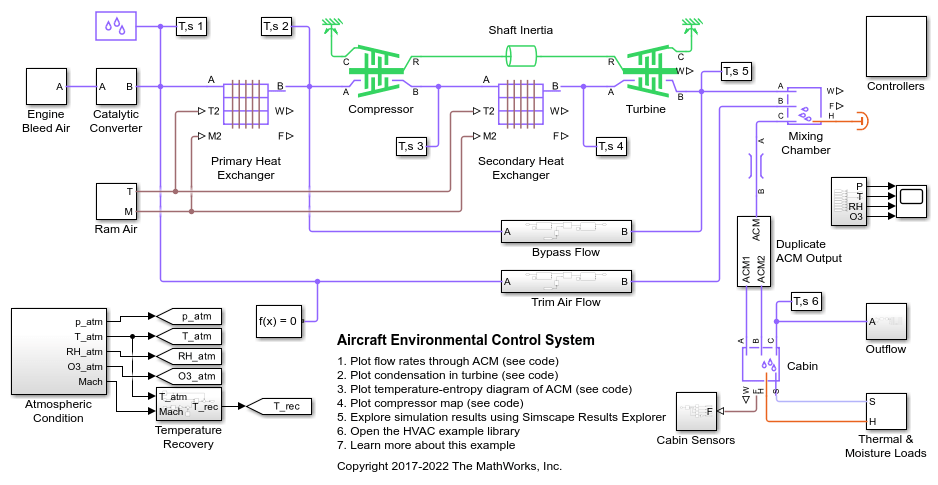Constant Volume Chamber (MA)
Chamber with fixed volume of moist air and variable number of ports
Libraries:
Simscape /
Foundation Library /
Moist Air /
Elements
Description
The Constant Volume Chamber (MA) block models mass and energy storage in a moist air network. The chamber contains a constant volume of moist air. It can have between one and four inlets. The enclosure can exchange mass and energy with the connected moist air network and exchange heat with the environment, allowing its internal pressure and temperature to evolve over time. The pressure and temperature evolve based on the compressibility and thermal capacity of the moist air volume. Liquid water condenses out of the moist air volume when it reaches saturation.
The block equations use these symbols. Subscripts a,
w, g, and d indicate the
properties of dry air, water vapor, trace gas, and water droplets, respectively.
Subscript ws indicates water vapor at saturation. Subscripts
A, H, and S indicate the
appropriate port. Subscript I indicates the properties of the
internal moist air volume.
| Mass flow rate | |
| Φ | Energy flow rate |
| Q | Heat flow rate |
| p | Pressure |
| ρ | Density |
| R | Specific gas constant |
| V | Volume of moist air inside the chamber |
| cp | Specific heat at constant volume |
| h | Specific enthalpy |
| u | Specific internal energy |
| x | Mass fraction (xw is specific humidity, which is another term for water vapor mass fraction) |
| y | Mole fraction |
| φ | Relative humidity |
| r | Humidity ratio |
| rd | Mass ratio of water droplets to moist air |
| T | Temperature |
| t | Time |
The net flow rates into the moist air volume inside the chamber are
where:
condense is the rate of condensation.
d,evap is the rate of water droplet evaporation.
Φcondense is the rate of energy loss from the condensed water.
λd is the value of the Fraction of condensate entrained as water droplets parameter.
ΦS is the rate of energy added by the sources of moisture and trace gas. and are mass flow rates of water and gas, respectively, through port S. The values of , , and ΦS are determined by the moisture and trace gas sources connected to port S of the chamber, or by the corresponding parameter values.
If a port is not visible, then the terms with the subscript corresponding to the port name are 0.
Water vapor mass conservation relates the water vapor mass flow rate to the dynamics of the humidity in the internal moist air volume:
Similarly, trace gas mass conservation relates the trace gas mass flow rate to the dynamics of the trace gas level in the internal moist air volume:
The water droplets mass conservation equation relates the water droplet mass flow rate to the entrained water droplet dynamics in the internal moist air volume
Mixture mass conservation relates the mixture mass flow rate to the dynamics of the pressure, temperature, and mass fractions of the internal moist air volume:
Finally, energy conservation relates the energy flow rate to the dynamics of the pressure, temperature, and mass fractions of the internal moist air volume:
The equation of state relates the mixture density to the pressure and temperature:
The mixture specific gas constant is
Flow resistance and thermal resistance are not modeled in the chamber:
When the moist air volume reaches saturation, condensation may occur. The specific humidity at saturation is
where:
φws is the relative humidity at saturation (typically 1).
pwsI is the water vapor saturation pressure evaluated at TI.
The rate of condensation is
where τcondense is the value of the Water vapor condensation time constant parameter.
The rate of evaporation is
where τevap is the value of the Water droplets evaporation time constant parameter.
Assumptions and Limitations
The chamber walls are perfectly rigid.
Flow resistance between the chamber inlet and the moist air volume is not modeled. Connect a Local Restriction (MA) block or a Flow Resistance (MA) block to port A to model the pressure losses associated with the inlet.
Thermal resistance between port H and the moist air volume is not modeled. Use Thermal library blocks to model thermal resistances between the moist air mixture and the environment, including any thermal effects of a chamber wall.



